1993 BUICK CENTURY engine
[x] Cancel search: enginePage 86 of 324
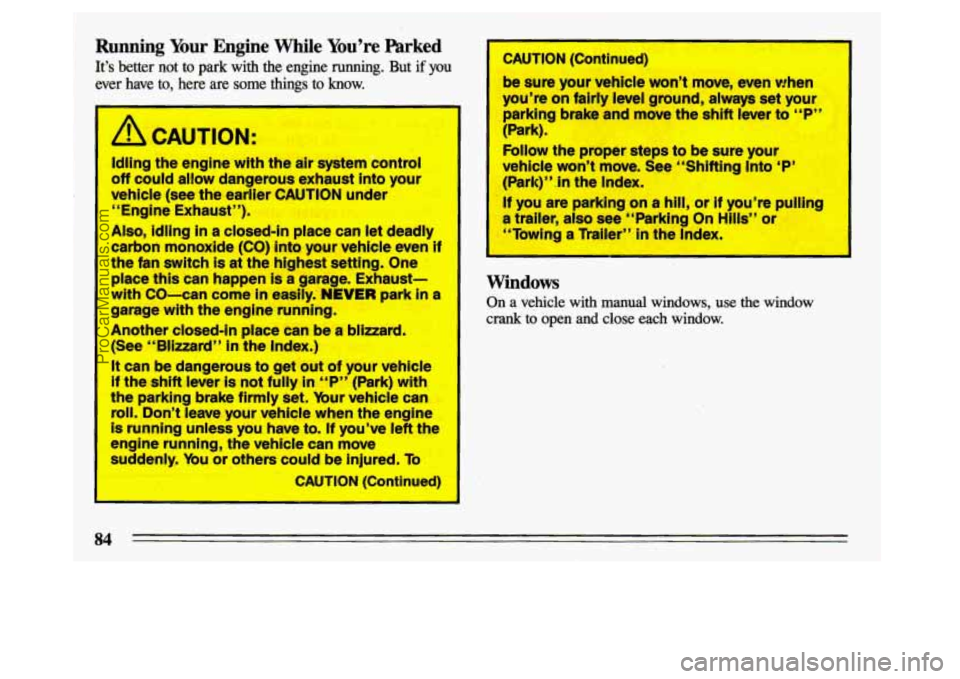
Running Your Engine While You’re Parked
It’s better not to park with the engine running. But if you
ever have to, here are some things to know.
1
I a CAUTION: I
Idling the engine with the air system “control
off could allow dangerous exhaust into your
vehicle (see the earlier
CAUTION under
“Engine Exhaust”).
Also, idling In a closed-in place can let deadly
carbon monoxide
(CO) into your vehicle even if
the fan switch is at the hlghest setting. One
place this can happen
is a garage. Exhaust-. -
with C0-n come in easily.’ NEVER park in a
garage wlth the engine running.
Another closed-in place can
be a blizzard.
It can be dpngeroua to get out of your vehicle
If the shift lever is not fully On “P” (Park) wlth
the parking
brake firmly set. bur vehicle can
roll. Don’t leave your vehicle when the engine
Os runnhg unless you. have to. If you’ve left the
engine running, the vehicle can move
suddenly.
Nu or others could be injured. To
I
I
I (See “Blizzard” In.the Index.)
CAUTION (Continued)
- - - -
I CAUTION (C __ ____ Jued) ..
be sureyour vehicle won’t move, even when
you’re on fairly level ground, always set your
parking
brake and move the shift lever to “P”,
(Park).
Follow the proper steps to be &re your
vehicle won’t move.
See “Shifting Into ‘P’
(Park)”.in the Index.
If you are parking on
a hill, or if you’re pulling
a trailer, also see “Parking On Hills” or
“Towing
a Thiler” in the Index.
i
Windows
On a vehicle with manual windows, use the window
crank
to open and close each window.
84
ProCarManuals.com
Page 109 of 324
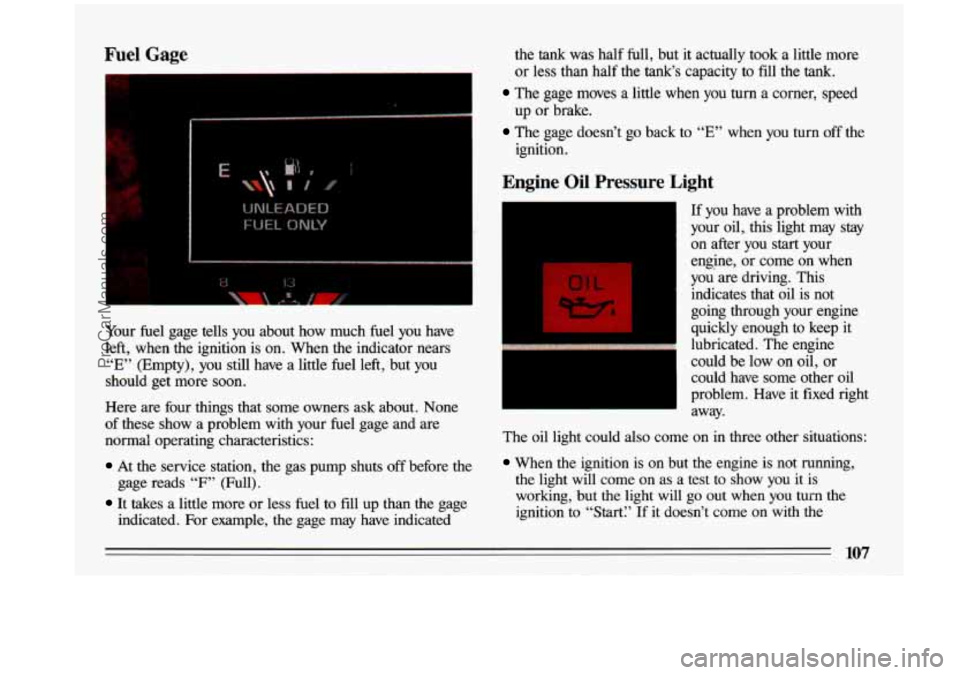
Fuel Gage
Your fuel gage tells you about how much fuel you have
left, when the ignition is on. When the indicator nears
“E” (Empty), you still have a little fuel left, but you
should get more
soon.
Here are four things that some owners ask about. None
of these show a problem with your fuel gage and are
normal operating characteristics:
At the service station, the gas pump shuts off before the
gage reads
“F” (Full).
It takes a little more or less fuel to fill up than the gage
indicated. For example, the gage may have indicated the tank was half
full, but it actually took
a little more
or less than half the
tank‘s capacity to fill the tank.
The gage moves a little when you turn a corner, speed
up or brake.
The gage doesn’t go back to “E” when you turn off the
ignition.
Engine Oil Pressure Light
If you have a problem with
your
oil, this light may stay
on after you start your
engine, or come on when
you are driving.
This
indicates that oil is not
going through your engine
quickly enough to keep it
lubricated. The engine could be low on oil, or
could have some other oil
problem. Have it fixed right
away.
The
oil light could also come on in three other situations:
When the ignition is on but the engine is not funning,
the light will come on as a test to show you it is
working, but the light will go out when
you turn the
ignition to “Start? If it doesn’t come on with the
107
ProCarManuals.com
Page 110 of 324
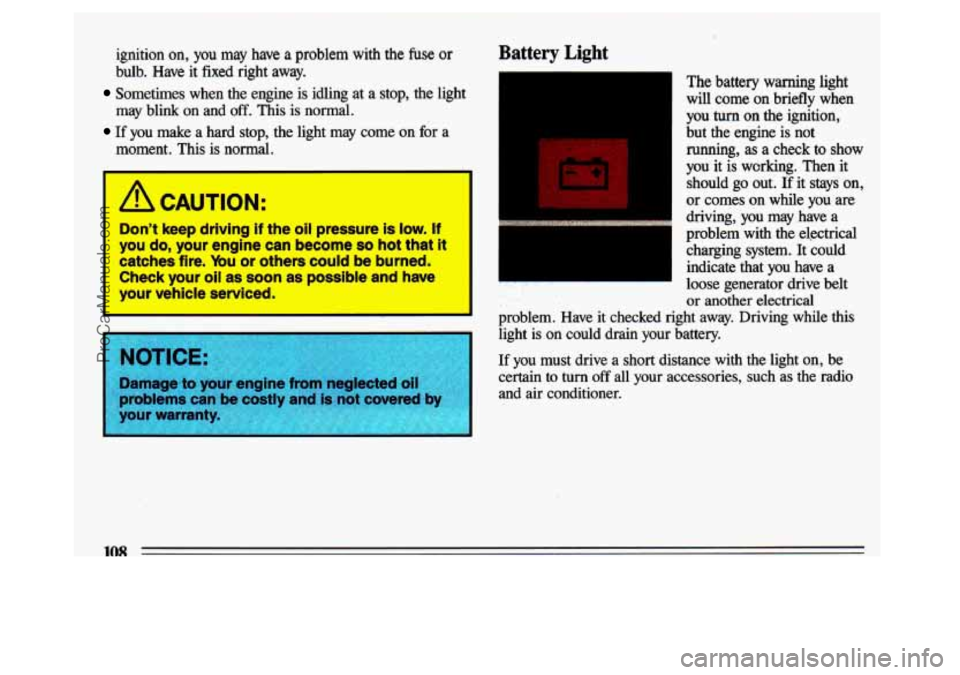
ignition on, you may have a problem with the fuse or
bulb. Have it fixed right away.
Sometimes when the engine is idling at a stop, the light
may blink on and
off. This is normal.
If you make a hard stop, the light may come on for a
moment.
This is normal.
1 A CAUTIONS
Don't keep driving if the oil pmssure is low. If
you do, your engine can become QO hot that It
catches flm. "ybu or others could be burned.
Check wur oil as soon as possible end have
your t rlcle senrlced.
I
Battery Light
The battery warning light
will come on briefly when
you
turn on the ignition,
but the engine is not
running, as a check to
show
you it is wcrking. Then it
should go out. If it stays on,
or comes on while you are
driving, you may have a
problem with the electrical
charging system. It could
indicate that you have a
or another electrical
. ., . loose generator drive belt
problem. Have it checked right away. Driving while this light is on could drain your battery.
If you must drive a short distance with the light on, be
certain to
turn off all your accessories, such as the radio
and air conditioner.
108
ProCarManuals.com
Page 111 of 324

Volts Gage (Option)
When your engine is not
running, but
the ignition is
on (in the “Run” position),
the gage shows your
battery’s state of charge
in
DC volts. When the engine
is running, the gage shows
the condition of the
charging system. Readings
between the red warning
zones indicate the normal
operating range.
Readings in either red
warning zone indicate a possible problem in the electrical
system. Have your vehicle serviced immediately.
Brake System Warning Light
Your Buick‘s hydraulic
brake system is divided into
two parts. If one part isn’t working, the other part can still work and stop you. For
good braking, though, you
need both parts working
well.
If the warning light
goes on, there could be a
brake problem. Have your
brake system inspected right away.
This light should come on
as you start the vehicle. If it doesn’t come on then, have it
fixed
so it will be ready to warn you if there’s a problem.
This light will also come on when you set your parking
brake, and will stay on if your parking brake doesn’t release
fully. If it stays on after your parking brake is
fully released, it means you have a brake problem.
If the light comes on while driving, pull
off the road and
stop carefully.
You may notice that the pedal is harder to
push. Or, the pedal may go closer to -the floor. It may take
longer to stop. If the light is still on, have the vehicle towed
for service. (See “Towing Your Buick” in the Index.)
109
ProCarManuals.com
Page 112 of 324

A CAUTION:
Your brake system may not be working properly
if the brake warning light is on.
Driving with the brake warning light on can
lead to an accident.
If the light is still on after
you’ve pulled
off the road and stopped
carefully, have the vehicle towed
for service.
Engine Coolant Temperature Warning Light
---I
This light tells you that
your engine coolant has
overheated or your radiator
cooling
fan is not working.
If you have been operating
your vehicle under normal
driving conditions, you should pull
off the road,
stop your vehicle and
turn
the engine off as soon as
possible.
HOT COOLANT CAN
BURN YOU BADLY!
In “Problems on the Road:’ this manual shows what to
do. See “Engine Overheating” in the Index.
Engine Coolant Temperature Gage (Option)
‘1 If you have the Gage
Cluster, you have a gage
that shows the engine
coolant temperature.
If the
gage pointer moves into the red area, your engine is too
hot! That reading means the same thing as the warning
light. It means that your engine coolant has
overheated. If you have
been operating your vehicle under normal driving
conditions, you should pull off the road, stop your-
vehicle and
turn off the engine as soon as possible.
Also, the temperature symbol on the gage will come on
when your engine is too hot.
HOT COOLANT CAN BURN YOU BADLY!
In “Problems on the Road:’ this manual shows what to
do. See “Engine Overheating” in the Index.
110
ProCarManuals.com
Page 113 of 324
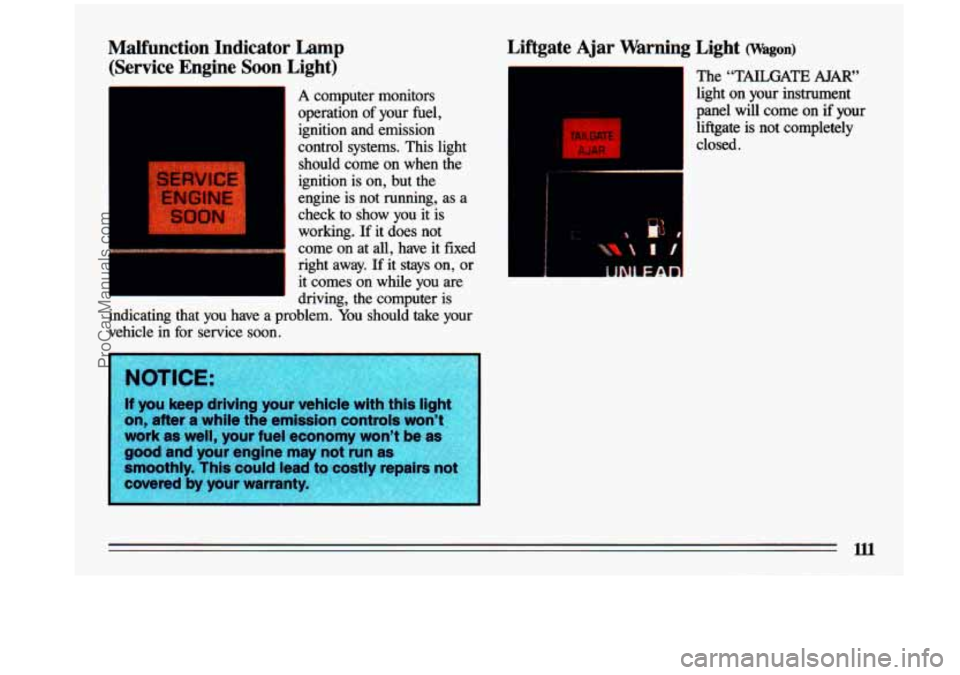
X"' 1 r-l
Malfunction Indicator Lamp
(Service Engine Soon Light)
A computer monitors
I operation of your fuel,
ignition and. emission
control systems. This light should come on when the
ignition is on, but the
engine is not running, as a
check to show
you it is
working.
If it does not
come on at all, have it fixed
right away.
If it stays on, or
it comes on while you are
driving, the computer is
I
indicating that you have a problem. You should take your
vehicle in
for service soon.
Liftgate Ajar Warning Light (Wagon)
.-
- The "TAILGATE AJAR"
~ light on your instrument
panel
will come on if your
I
TAI! GAY E
ALAR
liftgate is not completely
1 closed.
ProCarManuals.com
Page 117 of 324

The air conditioner compressor operates in all AIR COND
positions, and in DEF (Defrost) when the outside
temperature is above about 40°F (4.5"
C).
Ventilation
For mild outside temperatures, when little heating or
cooling is needed, slide the upper lever to
VENT. Air
flow is through the instrument panel outlets. Rotate the
control next to the outlets to turn on, adjust or
turn off
the air flow. Adjust the lower lever on the control panel
to the temperature desired.
Heating
When outside temperatures are cold, sliding the upper
lever to
HEATER and the lower lever to HOT will send
heated air through the heater ducts, and some through the
defroster vents.
VENT and HEAmR are labeled
ECONOMY positions because the air conditioner
compressor doesn't run
in these two settings. This
reduces engine load, resulting
in improved he1 economy.
If either setting fails to keep you comfortable, or causes
your windows
to fog up, slide the upper lever to one of
the
AIR COND positions, or to DEF (Defrost).
Defrosting
The DEF setting directs most of the air through the
defroster vents, and some through the heater ducts.
Defogging Windows with Four Season
Climate Control
To quickly defog the windshield, set the upper lever to
DEF and move the hn switch to HI. Slide the lower
lever
to HOT.
In damp, cool weather (temperatures about 45"-65"F,
7"- 18" C), you can use BI-LEV to defog the side windows.
Set the upper lever to
BI-LEV and the fan switch to HI.
Aim the side vents toward the side windows. For increased
air flow to the side vents, close the center vents.
Rear Window Defogger (Option)
--
The rear window defogger
uses
a warming grid to
remove fog from the rear
window.
In winter, it can
also keep ice from forming
on the rear window.
Press the
ON portion of the
switch. The indicator light
will glow. The rear window
defogger will
turn off
automatically after about
10
minutes of use. You can
also turn
it off by turning
off the ignition or pressing the
OFF portion of the
switch.
ProCarManuals.com
Page 150 of 324
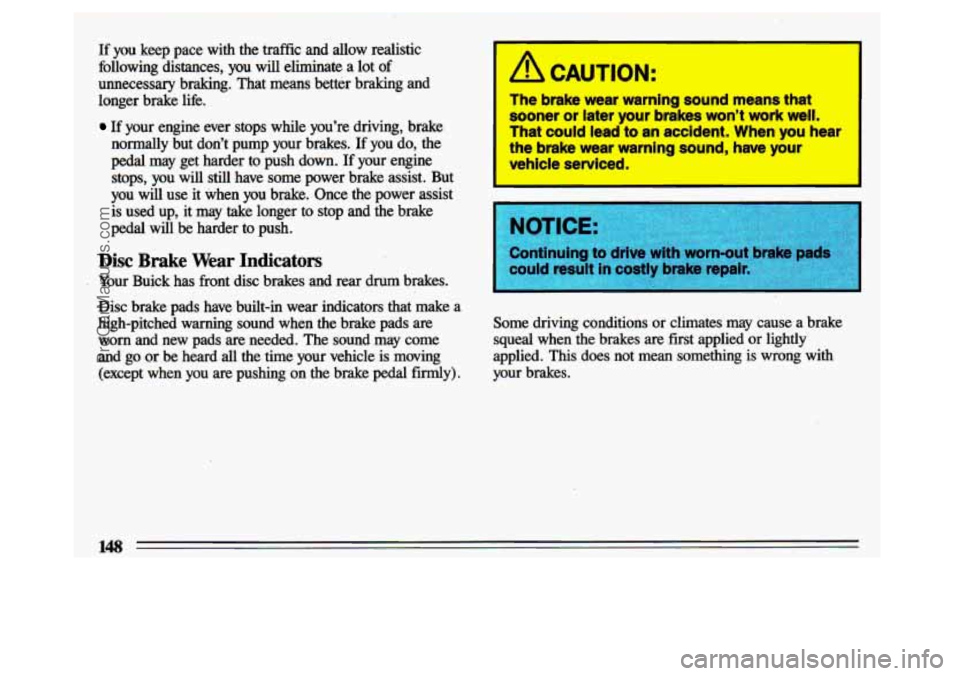
If you keep pace with the traffic and allow realistic
following distances, you
will eliminate a lot of
unnecessary braking. That means better braking and
longer brake life.
If your engine ever stops while you're driving, brake
normally but don't pump your brakes. If you do, the
pedal may get harder
to push down. If your engine
stops, you will still have some power brake assist. But
you will use it when
you brake. Once the power assist
is used up, it may take longer to stop and the brake
pedal will be harder to push.
Disc Brake Wear Indicators
Your Buick has front disc brakes and rear drum brakes.
I A CAUTION:
The brake wear wamlng sound means that
sooner or later pur brakes won't work well.
That could lead to an accident. When you hear
the brake wear warning sound, have your
vehlcle serviced.
I
Disc brake pads have built-in wear indicators that make a
high-pitched warning sound when the brake pads are Some driving conditions or climates may cause a brake
worn and new pads
are needed. The sound may come squeal when the brakes are first applied or lightly
and
go or be heard all the time your vehicle is moving applied. This do\
es not mean something is wrong with
(except when you are pushing on the brake pedal firmly). your brakes.
ProCarManuals.com